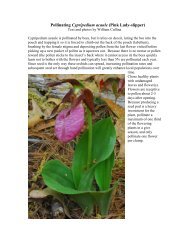Transplanting Pink lady-slipper (Cypripedium acaule) - William Cullina
Transplanting Pink lady-slipper (Cypripedium acaule) - William Cullina
Transplanting Pink lady-slipper (Cypripedium acaule) - William Cullina
Create successful ePaper yourself
Turn your PDF publications into a flip-book with our unique Google optimized e-Paper software.
You can also<br />
remove plants<br />
bare-root as<br />
long as you have<br />
damp burlap to<br />
cover them with<br />
until them are<br />
replanted. This<br />
smaller<br />
individual<br />
has<br />
one welldeveloped<br />
bud<br />
visible in the<br />
center of the<br />
image and a<br />
moderately<br />
sized root<br />
system.<br />
Blackened roots<br />
are stained by humic acids in the soil but still healthy. The white roots are younger.<br />
Lady-<strong>slipper</strong><br />
roots will<br />
continue to live<br />
and grow longer<br />
over the course<br />
of about 5 years.<br />
However, if the<br />
growing tip is<br />
damaged on a<br />
particular root, it<br />
cannot grow<br />
another. In this<br />
image, the<br />
healthy white<br />
root began<br />
growing this<br />
spring (after<br />
flowering) as<br />
did the slightly<br />
more stained<br />
one at the left. Notice that this second root has lost its tip and can grow no<br />
longer.<br />
The<br />
roots are all important to <strong>lady</strong>-<strong>slipper</strong>s as they not only take up water and nutrients<br />
(and perhaps carbohydrates from the fungus) but they also act as the primary foodstorage<br />
organ for the plant during dormancy. If roots are cut or damaged during




